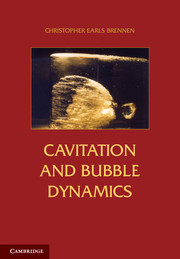2 - Spherical Bubble Dynamics
Published online by Cambridge University Press: 05 October 2013
Summary
Introduction
Having considered the initial formation of bubbles, we now proceed to identify the subsequent dynamics of bubble growth and collapse. The behavior of a single bubble in an infinite domain of liquid at rest far from the bubble and with uniform temperature far from the bubble will be examined first. This spherically symmetric situation provides a simple case that is amenable to analysis and reveals a number of important phenomena. Complications such as those introduced by the presence of nearby solid boundaries will be discussed in the chapters which follow.
Rayleigh-Plesset Equation
Consider a spherical bubble of radius, R(t) (where t is time), in an infinite domain of liquid whose temperature and pressure far from the bubble are T∞ andp∞(t) respectively. The temperature, T∞, is assumed to be a simple constant since temperature gradients were eliminated a priori and uniform heating of the liquid due to internal heat sources or radiation will not be considered. On the other hand, the pressure, P∞(t), is assumed to be a known (and perhaps controlled) input which regulates the growth or collapse of the bubble.
Though compressibility of the liquid can be important in the context of bubble collapse, it will, for the present, be assumed that the liquid density, ρL, is a constant. Furthermore, the dynamic viscosity, μL, is assumed constant and uniform. It will also be assumed that the contents of the bubble are homogeneous and that the temperature, TB(t), and pressure, pB(t), within the bubble are always uniform.
- Type
- Chapter
- Information
- Cavitation and Bubble Dynamics , pp. 30 - 58Publisher: Cambridge University PressPrint publication year: 2013
References
- 3
- Cited by



